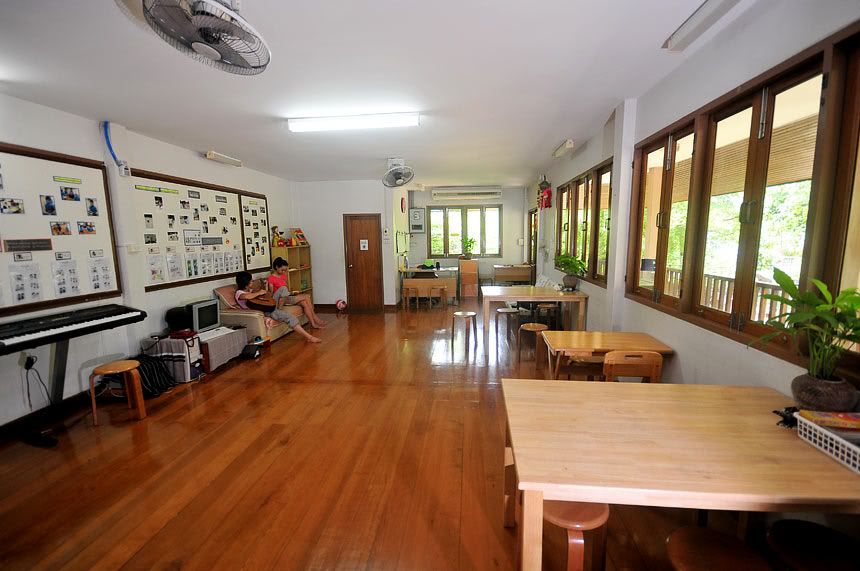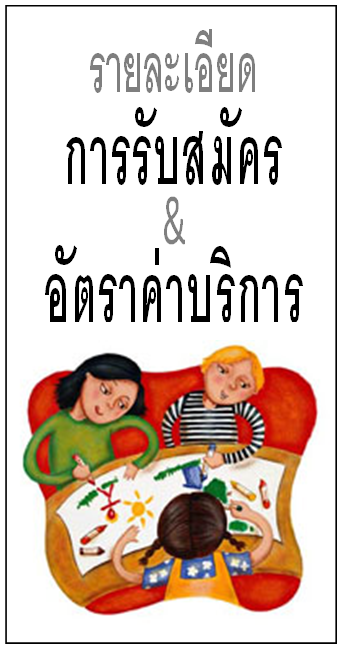IEP... คืออะไร?

"...เราอาจเปรียบเทียบ IEP ได้ราวกับเป็น Road Map ที่ถูกสร้างขึ้น สำหรับเด็กพิเศษแต่ละคนโดยเฉพาะ เพื่อช่วยให้พวกเขาสามารถเดินทางผ่านประสบการณ์ต่างๆ ที่ถูกจัดวางไว้ ในแต่ละขั้น แต่ละตอน ตามลำดับ อย่างมีเหตุมีผล อย่างเหมาะสม และสมดุล ในที่สุดเด็กๆ ทุกคนจะบรรลุถึงเป้าหมายทางการศึกษาอย่างมีวุฒิภาวะ และมองตัวเองอย่างผู้ที่ประสบความสำเร็จ..."
FAQ คำถามที่ถามบ่อย

การเลือกโรงเรียนสำหรับเด็กพิเศษ
"...ถึงเวลาขานรับการกลับมาของหน้าฝนอีกครั้ง เมื่อรอยต่อแห่งฤดูกาลได้พัดพาให้ฤดูแล้งผ่านพ้นไป ชักนำฝนแรกให้โปรยปรายพร่างพรมนำความชุ่มชื้นมาสู่ผืนแผ่นดินอีกครา อีกไม่นานเหล่ามวลดอกไม้ก็จะเริ่มผลิดอกบานสะพรั่ง..."
นี่เป็นเวลาของการเปลี่ยนแปลง อาจบางทีเช่นเดียวกับพ่อแม่ของเด็กอีกหลายๆ คน ที่กำลังมองหาทางเลือก มองหาโรงเรียนสำหรับเด็กพิเศษอย่างลูก
รวมภาพฝัน... วันฟ้าสวย
เปรียบดั่งเช่นการเดินทางไกล ที่เราจะพบว่า มีเรื่องราวต่างๆ มากมายให้ค้นหา มีอุปสรรคที่ต้องฟันฝ่า รวมถึงยังมีความยากลำบากที่ท้าทาย แต่ในขณะเดียวกันก็ช่วยหล่อหลอมจิตใจให้แข็งแกร่งได้เช่นกัน
ทุกวันนี้ เด็กๆแห่งบ้านเพียงตะวันฯ ยังคงอยู่บนเส้นทางของพวกเขา มีความสุขกับภารกิจต่างๆ ที่ได้รับมอบหมาย ยังคงฝึกตน และมุ่งมั่นเพื่อให้ถึงจุดหมายปลายทาง วิธีการเช่นนี้ไม่ง่ายนัก แต่ได้ผล
นี่เป็นภาพบางส่วนที่พวกเขาช่วยกันเติมเต็ม และบันทึกไว้เป็นความทรงจำที่ดีที่มีร่วมกัน ย้ำเตือนให้เราทุกคนเห็นถึงคุณค่าของคำว่า "มิตรภาพ" ว่ามีความหมายเพียงใด

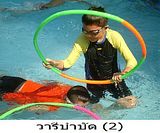
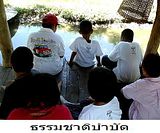
กาลครั้งหนึ่ง... ที่บ้านเพียงตะวันฯ
| ราวลูกปัดเลื่อมลายหลากหลายสี นำมาร้อยมาลัยรักทักทอใจ |
ดุจมณีรุ้งแก้วแววสดใส สืบสายใยสู่ฝันวันฟ้างาม |
| ประพันธ์โดย: ครูทิพย์ |

เพราะหนทางข้างหน้านั้น... มีเธอ
 โครงการเดีกพิเศษ อนุบาล-ประถม 6 ศูนย์การศึกษาเฉพาะบุคคล "เพียงตะวัน เคียงเดือน" เปิดรับสมัครเด็กพิเศษเข้าเรียนในระดับชั้น อนุบาล - ประถม6 ทั้งแบบ "ไปเช้า-เย็นกลับ" และ "นักเรียนประจำ" สอบถามรายละเอียดเพิ่มเติม ได้ที่ 02-868-5973, 066-129 -9912
โครงการเดีกพิเศษ อนุบาล-ประถม 6 ศูนย์การศึกษาเฉพาะบุคคล "เพียงตะวัน เคียงเดือน" เปิดรับสมัครเด็กพิเศษเข้าเรียนในระดับชั้น อนุบาล - ประถม6 ทั้งแบบ "ไปเช้า-เย็นกลับ" และ "นักเรียนประจำ" สอบถามรายละเอียดเพิ่มเติม ได้ที่ 02-868-5973, 066-129 -9912

Holistic Education
Holistic education is a philosophy of education based on the premise that each person finds identity, meaning, and purpose in life through connections to the community, to the natural world, and to humanitarian values such as compassion and peace. Holistic education aims to call forth from people an intrinsic reverence for life and a passionate love of learning. This is the definition given by Ron Miller, founder of the journal Holistic Education Review (now entitled Encounter: Education for Meaning and Social Justice). The term holistic education is often used to refer to the more democratic and humanistic types of alternative education. Robin Ann Martin (2003) describes this further by stating, “At its most general level, what distinguishes holistic education from other forms of education are its goals, its attention to experiential learning, and the significance that it places on relationships and primary human values within the learning environment.” (Paths of Learning)
The concept of holism refers to the idea that all the properties of a given system in any field of study cannot be determined or explained by the sum of its component parts. Instead, the system as a whole determines how its parts behave. A holistic way of thinking tries to encompass and integrate multiple layers of meaning and experience rather than defining human possibilities narrowly.Contents [show]
Key Historical Contributors
It is difficult to map the history of holistic education because many feel that the core ideas of holism are not new but “timeless and found in the sense of wholeness in humanity’s religious impetus” (Forbes,1996).[1] On the other hand, the roots of holistic education can be traced back to several major contributors. Originating theorists include Jean-Jacques Rousseau, Ralph Waldo Emerson, Henry Thoreau, Bronson Alcott, Johann Pestalozzi, Friedrich Fröbel, and Francisco Ferrer. More recent theorists are Rudolf Steiner, Maria Montessori, Francis Parker, John Dewey, John Caldwell Holt, George Dennison Kieran Egan, Howard Gardner, Jiddu Krishnamurti, Carl Jung, Abraham Maslow, Carl Rogers, Paul Goodman, Ivan Illich, and Paulo Freire. With the ideas of these pioneers in mind, many feel that the core ideas of holistic education did not truly take form until the cultural paradigm shift that began in the 1960s.[1] After this, the holism movement in psychology emerged in the 1970s where, during this time, “an emerging body of literature in science, philosophy and cultural history provided an overarching concept to describe this way of understanding education – a perspective known as holism.”[2]
Significant forward motion was accomplished by the first National Holistic Education Conference that was conducted with The University of California, San Diego in July 1979, that included 31 workshops. The Conference was presented by The Mandala Society and The National Center for the Exploration of Human Potential.
The title was Mind: Evolution or Revolution? The Emergence of Holistic Education
For six years after that the Holistic Education Conference was combined with the Mandala Holistic Health Conferences at the University of California, San Diego, with about three thousand professionals participating each year.
Out of this came the Journal of Holistic Education and the observation that educators think they are teaching the basic three R’s: Reading Writing and Arithmetic. With Holistic Education the basic three R’s are Education for: Relationships, Responsibility and Reverence for all life.
Philosophical Framework
Any approach to education must ask itself, what is the goal of education? Holistic education aims at helping students be the most that they can be. Abraham Maslow referred to this as “self-actualization”. Education with a holistic perspective is concerned with the development of every person’s intellectual, emotional, social, physical, artistic, creative and spiritual potentials. It seeks to engage students in the teaching/learning process and encourages personal and collective responsibility.
In describing the general philosophy of holistic education, Robin Ann Martin and Scott Forbes (2004) divide their discussion into two categories: the idea of Ultimacy and Basil Bernstein’s notion of Sagacious Competence. [3]
Ultimacy
- Religious; as in becoming “enlightened”. Spirituality is an important component in holistic education as it emphasizes the connectedness of all living things and stresses the “harmony between the inner life and outer life” (Holistic Education Network).
- Psychological; as in Maslow’s “self-actualization”. Holistic education believes that each person should strive to be all that they can be in life. There are no deficits in learners, just differences.
- Undefined; as in a person developing to the ultimate extent a human could reach and, thus, moving towards the highest aspirations of the human spirit (Holistic Education Network).
Sagacious Competence
- Freedom (in a psychological sense).
- Good-judgment (self-governance).
- Meta learning (each student learns in their “own way”).
- Social ability (more than just learning social skills).
- Refining Values (development of character).
- Self Knowledge (emotional development).
Curriculum
In considering curriculum using a holistic approach, one must address the question of what children need to learn. Since holistic education seeks to educate the whole person, there are some key factors that are essential to this type of education. First, children need to learn about themselves. This involves learning self respect and self esteem. Second, children need to learn about relationships. In learning about their relationships with others, there is a focus on social “literacy” (learning to see social influence) and emotional “literacy” (one’s own self in relation to others). Third, children need to learn about resilience. This entails overcoming difficulties, facing challenges and learning how to ensure long-term success. Fourth, children need to learn about aesthetics – This encourages the student to see the beauty of what is around them and learn to have awe in life. (Holistic Education, Inc, Home Page)
Dr. Ramon Gallegos Nava describes at least six dimensions of thinking and expression that should be taken into account in teaching and learning:
Model of the Integration of Holistic Education from the Holistic Education Network.
Clifford Mayes and his associates have recently written a book-length study entitled Understanding the Whole Student: Holistic Multicultural Education (Rowman and Littlefield: 2007), which extends the idea of holistic education to critical issues in the theory and practice of multicultural education.
Tools/Teaching Strategies of Holistic Education
With the goal of educating the whole child, holistic education promotes several strategies to address the question of how to teach and how people learn. First, the idea of holism advocates a transformative approach to learning. Rather than seeing education as a process of transmission and transaction, transformative learning involves a change in the frames of reference that a person may have. This change may include points of view, habits of mind, and worldviews. Holism understands knowledge as something that is constructed by the context in which a person lives. Therefore, teaching students to reflect critically on how we come to know or understand information is essential. As a result, if “we ask students to develop critical and reflective thinking skills and encourage them to care about the world around them they may decide that some degree of personal or social transformation is required.” [4]
Second, the idea of connections is emphasized as opposed to the fragmentation that is often seen in mainstream education. This fragmentation may include the dividing of individual subjects, dividing students into grades, etc. Holism sees the various aspects of life and living as integrated and connected, therefore, education should not isolate learning into several different components. Martin (2002) illustrates this point further by stating that, “Many alternative educators argue instead that who the learners are, what they know, how they know it, and how they act in the world are not separate elements, but reflect the interdependencies between our world and ourselves” ([1]). Included in this idea of connections is the way that the classroom is structured. Holistic school classrooms are often small and consist of mixed-ability and mixed-age students. They are flexible in terms of how they are structured so that if it becomes appropriate for a student to change classes, (s)he is moved regardless of what time of year it is on the school calendar. Flexible pacing is key in allowing students to feel that they are not rushed in learning concepts studied, nor are they held back if they learn concepts quickly.
Third, along the same thread as the idea of connections in holistic education, is the concept of transdisciplinary inquiry. Transdisciplinary inquiry is based on the premise that division between disciplines is eliminated. One must understand the world in wholes as much as possible and not in fragmented parts. “Transdisciplinary approaches involve multiple disciplines and the space between the disciplines with the possibility of new perspectives ‘beyond’ those disciplines. Where multidisciplinary and interdisciplinary inquiry may focus on the contribution of disciplines to an inquiry transdisciplinary inquiry tends to focus on the inquiry issue itself.”[5]
Illustration of how transdisciplinary inquiry works from the Holistic Education Network.
Fourth, holistic education feels that meaningfulness is also an important factor in the learning process. People learn better when what is being learned is important to them. Holistic schools seek to respect and work with the meaning structures of each person. Therefore, the start of a topic would begin with what a student may know or understand from their worldview, what has meaning to them rather than what others feel should be meaningful to them. Meta-learning is another concept that connects to meaningfulness. In finding inherent meaning in the process of learning and coming to understand how they learn, students are expected to self-regulate their own learning. However, they are not completely expected to do this on their own. Because of the nature of community in holistic education, students learn to monitor their own learning through interdependence on others inside and outside of the classroom.
Finally, as mentioned above, community is an integral aspect in holistic education. As relationships and learning about relationships are keys to understanding ourselves, so the aspect of community is vital in this learning process. Forbes (1996) states, “In holistic education the classroom is often seen as a community, which is within the larger community of the school, which is within the larger community of the village, town, or city, and which is, by extension, within the larger community of humanity.”[1]
Teacher’s Role
In holistic education, the teacher is seen less as person of authority who leads and controls but rather is seen as “a friend, a mentor, a facilitator, or an experienced traveling companion” (Forbes, 1996).[1] Schools should be seen as places where students and adults work toward a mutual goal. Open and honest communication is expected and differences between people are respected and appreciated. Cooperation is the norm, rather than competition. Thus, many schools incorporating holistic beliefs do not give grades or rewards. The reward of helping one another and growing together is emphasized rather than being placed above one another.
Alternative Schools
For various reasons, many parents today are looking to alternative schools that offer different philosophies of education than mainstream schools. The diversity of alternative schools sets them apart from mainline education. Each school has its own methods and approaches to teaching. Therefore, each alternative school may have different beliefs about what education should include. Consequently, there are several types of alternative schools that have holistic values in their philosophies of education. While these schools have elements of holism incorporated in their values it would be fair to say that these schools could be placed on a continuum on how “holistic” they actually are (that is to say, some would have more holistic elements than others). Also, public and other types of private schools do not appear in the following list but that does not mean that there are no holistic values in their individual philosophies of education. In addition, many individual teachers in different venues of education try to incorporate ideas of holism into their own classrooms.
List of alternative schools that have holistic elements of learning in their educational philosophies:
Camphill Schools
Democratic school and Free school
Folk Education
Friends/Quaker Schools
Homeschooling, Unschooling, and Deschooling
Krishnamurti Schools
Montessori Schools (see Montessori Method)
Open Schools
Waldorf Education (or Steiner Education)
Note on semantics
There is a debate on whether holistic education is connected to the idea of holistic education which is used to refer to education in holistic health or spiritual practices such as massage and yoga. Some educators feel that holistic education is a part of holistic practices, while others feel that they are totally separate concepts.
บ้านนี้จะมีความงามได้... ถ้ามีเธอ
|
|
ดอกไม้ที่หลากสี... กิจกรรมที่หลากหลาย





"ที่เพียงตะวันฯ มีที่ว่างเสมอสำหรับเด็กทุกคน..."


ประเด็นถัดมา หากพิจารณาในแง่ผัสสะที่นำไปสู่การรับรู้ (Sensation and Perception) อาจกล่าวได้ว่า คงไม่มีสิ่งใดเข้าถึงพวกเขาได้ดีกว่าดนตรีอีกแล้ว เพราะมิใช่แค่เพียงเสียงที่ได้ยิน แต่ลุ่มลึกหยั่งลงไปถึงจิตวิญญาณ เพราะเหตุนี้ ดนตรีบำบัด (Music therapy) จึงถูกนำมาใช้กันอย่างแพร่หลาย ดนตรีมีผลต่อการเปลี่ยนแปลงของร่างกาย จิตใจ และการทำงานของสมองในหลาย ๆ ด้าน ทั้งเรื่อง อัตราการหายใจ อัตราการเต้นของชีพจร ความดันโลหิต การตอบสนองของม่านตา ความตึงตัวของกล้ามเนื้อ และการไหลเวียนของเลือด จึงช่วยในการบำบัดรักษาโรคภัยไข้เจ็บทั้งร่างกายและจิตใจ นอกจากนี้ยังช่วยปรับสภาพจิตใจ ให้อยู่ในสภาวะสมดุล มีมุมมองในเชิงบวก ผ่อนคลายความตึงเครียด ลดความวิตกกังวล กระตุ้น เสริมสร้าง และพัฒนาทักษะการเรียนรู้ และความจำ กระตุ้นประสาทสัมผัส การรับรู้ เสริมสร้างสมาธิ พัฒนาทักษะสังคม พัฒนาทักษะการสื่อสารและการใช้ภาษา พัฒนาทักษะการเคลื่อนไหว ลดความตึงตัว ของกล้ามเนื้อ และช่วยเสริมในกระบวนการบำบัดทางจิตเวช ทั้งในด้านการประเมินความรู้สึก การควบคุมตนเอง การแก้ปมขัดแย้งต่าง ๆ และการสร้างเสริมอารมณ์เชิงบวก ที่บ้านเพียงตะวันฯ เราใช้เสียงดนตรีอะคลูสติดเป็นส่วนหนึ่งในการดำเนินงานกิจกรรมบำบัด

วารีบำบัด ในรูปแบบของการจัดกิจกรรมกลุ่มในสระว่ายน้ำสำหรับเด็กพิเศษโดยเฉพาะ จะช่วยส่งเสริมพัฒนาการทางด้านร่างกาย ช่วยให้ระบบประสาทที่ทำหน้าที่ควบคุมการเคลื่อนไหวมีประสิทธิภาพมากขึ้น มีการประสานงานที่ดีขึ้น เพิ่มความแข็งแรงของกล้ามเนื้อที่อ่อนแอ อาศัยประโยชน์จากภาวะของน้ำที่จะช่วยพยุงน้ำหนักของส่วนต่างๆ ของร่างกายเอาไว้นำมาขยายขอบเขตของการออกกำลังกายให้มากยิ่งขึ้น ช่วยฟื้นฟูระบบทางเดินหายใจ รวมถึงยังเป็นการช่วยส่งเสริมพัฒนาการทางด้านอื่นๆ เช่น การบำบัดด้านสมาธิและความสนใจ (Attention Deficit Problem) ตลอดจนการจัดกิจกรรมบำบัดสำหรับกลุ่มย่อย (Treatment for children with joint problems) อีกทั้งเด็กๆ ยังได้มีโอกาสฝึกหัดว่ายน้ำอีกด้วย
ส่วนอาชาบำบัด ได้ถูกนำมาใช้เพื่อการบำบัดเด็กพิเศษ ทั้งทางด้านกายภาพ ซึ่งได้แก่ปัญหาต่างๆ เกี่ยวกับระบบการเคลื่อนไหว การทรงตัว ความสมมาตรของร่างกาย ระบบประสาท และกล้ามเนื้อ รวมถึงด้านจิตใจ อารมณ์และพฤติกรรมต่างๆ อีกด้วย
"...เมื่อใดก็ตามที่พวกเด็กๆ อยู่บนหลังม้า ด้วยสัญชาตญาณแห่งการเอาตัวรอดของมนุษย์ จะนำพาพวกเขาให้ใช้ศักยภาพทั้งหมดที่มีเพื่อปรับตนเอง ระบบและกลไกทางกายภาพทั้งหมดจะต้องถูกควบคุม และดำเนินการภายใต้การสั่งการผู้เป็นเจ้าของร่าง สมดุลและสมมาตรต้องมีให้ได้ พลังงานทั้งหมดจะต้องถูกนำมาใช้ เพียงเพื่อให้ทรงตัวอยู่รอด มิให้ตกจากหลังม้า พวกเขารู้ว่าหากเกรี้ยวกราด เอาแต่ใจตนเองดั่งที่เคย อาจทำให้ม้าไม่พอใจ และพวกเขารู้อีกว่า หากพวกเขาว็อกแวก ไม่สามารถควบคุมตัวเองได้ ขาดสติกำกับตน หรือสมาธิสั้นเกินกว่าจะรับมือกับภารกิจนี้ อาจทำให้หายนะบังเกิด ดังนั้นในภาวะขับขันเช่นนี้ ไม่ว่าต่อมอะตรีนาลีนจะถูกกระตุ้นให้ทำงานเต็มพิกัดหรือไม่ พวกเขารู้แต่เพียงว่า พวกเขาต้องเป็นฝ่ายชนะเท่านั้น!..."
และท้ายที่สุด พวกพวกเขายังเรียนรู้ถึงการแบ่งปันความรักและความรู้สึกที่ดีให้กับม้า สัตว์ที่มีความฉลาดเป็นอย่างยิ่ง เด็กที่ก้าวร้าวกลับอ่อนโยนขึ้น จิตใจได้ถูกหล่อหลอมกล่อมเกลาโดยไม่รู้ตัวในขณะที่พวกเขาลูบสัมผัสม้า ไม่นานนักพวกเขาก็สามารถหยั่งถึงความรู้สึกแห่งความโอบอ้อมอารีที่พึงมีได้ในจิตใจที่ละเอียดอ่อน
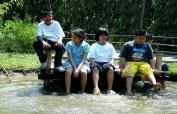
ที่บ้านเพียงตะวันฯ ให้ความสำคัญและพยายามที่จะปลูกฝัง "สำนึกแห่งความเป็นเพื่อน" (Sense of Friendship) ให้เกิดขึ้นกับเด็กๆ ทุกคน กิจกรรมหลายๆ อย่างที่ถูกจัดขึ้นได้ถูกสอดแทรกเรื่องราวเหล่านี้หลอมรวมเข้าไว้อยู่เสมอ มิใช่เพียงเพราะว่านี่คือส่วนหนึ่งของการส่งเสริมทักษะทางสังคม หรือการจัดเตรียมเครือข่ายให้พวกเขาในอนาคตเท่านั้น แต่เรารู้ว่านี่คือ กุญแจไขปริศนา อันนำไปสู่แสงสว่างที่ปลายอุโมงค์
สมดุลแห่งชีวิต... สมดุลแห่งการบำบัดที่บ้านเพียงตะวันฯ
ที่บ้านเพียงตะวันฯ เราใช้หลักการจัดกิจกรรมบำบัดในรูปแบบองค์รวม ที่คำนึงถึงความสมดุลของสุขภาวะทั้งสาม คือ กาย ใจ และจิตวิญญาณ (Physical/Metal/Spiritual Well-Being) อันนำไปสู่สภาวะสมดุลแห่งชีวิต ที่มนุษย์สามารถดำรงชีพและดำเนินชีวิตในสังคมได้อย่างสงบศานติสุข

ร่างกาย (Body)
สุขภาวะทางกาย เป็นภาวะที่มนุษย์รับรู้และสามารถดำรงตนให้มีสุขภาพร่างกายที่สมบูรณ์แข็งแรง ระบบต่างๆ รวมทั้งอวัยวะทั้งหมดทั้งองคาพยพทำงานสอดประสานกันอย่างถูกต้องเป็นปกติสุข ผัสสะนำมาซึ่งการรับที่ถูกต้องไม่บิดเบือน อโรคยาคือปราศจากโรคภัยไข้เจ็บ อีกทั้งมีวิถีการดำเนินชีวิตที่สอดคล้อง กลมกลืน และเหมาะสมกับบริบทของตน คือ เพศ วัย สภาพร่างกาย และสภาพแวดล้อม

จิตใจ (Mind)
สุขภาวะทางจิตใจ เป็นภาวะที่มนุษย์มีสภาพจิตใจที่ดีงาม หนักแน่น มีอารมณ์ที่มั่นคง สามารถควบคุมได้ เพราะมีสติกำกับตนอยู่เสมอ จิตใจเปี่ยมไปด้วยปีติ คือความอิ่มเอิมใจ ความดื่มด่ำที่หยั่งลึกลงถึงก้นบึ้งของหัวใจ มีความเบิกบานเป็นอย่างยิ่ง มีความสงบเย็นเป็นที่สุด ที่เป็นเช่นนี้เพราะจิตได้รับการฝึกฝนมาอย่างถูกต้อง ได้รับการพัฒนาอย่างเป็นขั้นเป็นตอนตามลำดับ สามารถดำเนินชีวิตได้อย่างมีความสุข

จิตวิญญาณ (Spirit)
สุขภาวะทางจิตวิญญาณ เป็นมิติที่สูงส่งของจิต กล่าวคือ มีจิตใจที่สูงขึ้น ละเอียดปราณีตขึ้น โน้มนำไปในทางที่ดีงามเป็นศิริ เป็นมงคล เป็นภาวะที่จิตสามารถเข้าถึงสิ่งสูงสุด ในทางพุทธหมายถึงปัญญา จิตวิญญาณสูงทำให้มีสุขภาวะ (Well being) จิตใจผ่อนคลาย เป็นอิสระท่ามกลางปัญหาและความวุ่นวาย แต่ยังคงความสงบ ความสุข ตลอดทั้งร่างกายและจิตใจ
ต่างคนเติมใจให้กัน... จนเต็ม
เพลง: เติมใจให้กัน คำร้อง/ทำนอง: ศุ บุญเลี้ยง/สินนภา สารสาส ร้อง: ก้อง สหรัฐ สังคปรีชา
|
อยู่ไกลกัน เกินครึ่งฟ้า
จะโยงใย ความสัมพันธ์
ต่อเติม แรงใจเมื่อท้อ
ต่างคน เติมใจให้กัน
|
หากยังมีใจถึงกัน
จนมาพบกันใกล้ตา
แบ่งปันในยามทุกข์ตรม...ไม่หวั่น
เติมใจซึ่งกัน...จนเต็ม
|
Kseniya Simonova's Amazing Sand Drawing
คำขวัญ... ขวัญเจ้ามาสู่เรือนตน

คือฉัน...คือเธอ
คือพี่...คือน้อง
คือผองเพื่อน...ที่ผูกพัน
หนึ่งในบรรดาคำถามคลาสสิคมากที่สุดในทางอภิปรัชญา ก็คือ "ฉันคือใคร? ฉันเหมือนหรือแตกต่างจากผู้อื่นตรงไหน?" นี่คือรากเหง้าแห่งวิถีความคิดของ "เพียงตะวันฯ" ที่ใช้ในการก่อร่างสร้าง "วัฒนธรรมบ้านเพียงตะวันฯ" ซึ่งทุกๆ คนตระหนักและยอมรับในเรื่องความเป็นปัจเจกของแต่ละบุคคล ความแตกต่างของผู้อื่นที่ไม่เหมือนกับตน การอยู่รวมกันอย่างพึ่งพิง ทุกคนช่วยกันทักทอเป็นโครงข่ายโยงใยความสัมพันธ์ซึ่งกันและกัน มิใช่เพียงแค่วันนี้แต่หมายรวมไปถึงความผูกพันในวันข้างหน้าสืบไป...
